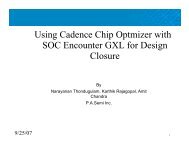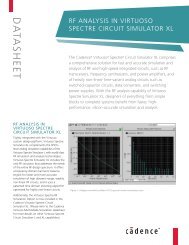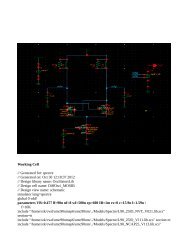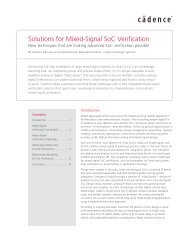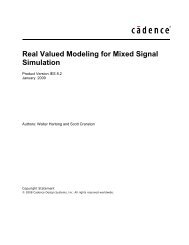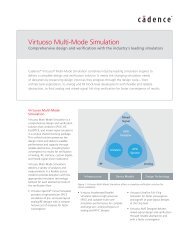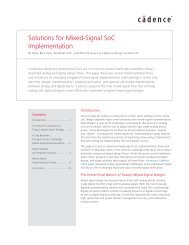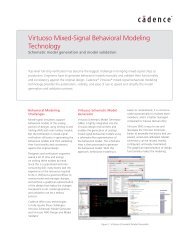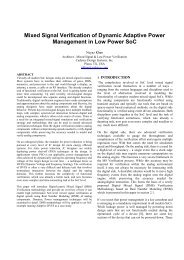Affirma Spectre DC Device Matching Analysis Tutorial - Cadence ...
Affirma Spectre DC Device Matching Analysis Tutorial - Cadence ...
Affirma Spectre DC Device Matching Analysis Tutorial - Cadence ...
You also want an ePaper? Increase the reach of your titles
YUMPU automatically turns print PDFs into web optimized ePapers that Google loves.
<strong>Affirma</strong> <strong>Spectre</strong> <strong>DC</strong> <strong>Device</strong> <strong>Matching</strong> <strong>Analysis</strong> <strong>Tutorial</strong><br />
Mismatch modeling<br />
1. Use Model<br />
After identifying the output, the user needs to specify the parameters for each device<br />
contributing to the mismatch. Currently, The mismatch model implemented in <strong>Spectre</strong> for<br />
Mosfet transistors introduces five additional model parameters, one for bjts and nine for<br />
resistors.<br />
To start the dc-mismatch analysis, the user types the analysis statement with the output<br />
voltage on which the dc-mismatch analysis is to be performed. The results are:<br />
1) The 3-sigma random output variation<br />
2) The dc operating point information<br />
3) For each Mosfet:<br />
• 3-sigma output variation,<br />
• 3-sigma Beta variation,<br />
• 3-sigma Threshold voltage variation, 3σ(ΔVth)<br />
• 3-sigma gate voltage variation, 3σ(ΔVg)<br />
• 3-sigma current mismatch to nominal current ratio,<br />
4) For each BJT<br />
• 3-sigma output variation,<br />
∂<br />
3σ( ΔIds)<br />
Vout<br />
∂ΔIds<br />
3σ( Δβ)<br />
-----------------β0<br />
∂<br />
3σ( ΔIc)<br />
Vout<br />
∂ΔIc<br />
• 3-sigma Vbe Variation, 3σ(ΔVbe)<br />
3σ( ΔIds)<br />
-----------------------<br />
Ids0 Release Date Back Page 14<br />
Close<br />
14






